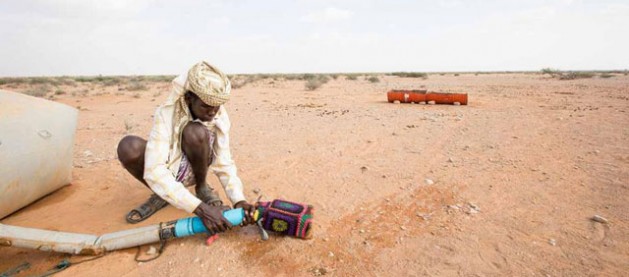No Water, No Life – Don’t Waste It!
ENVIRONMENT, SPOTLIGHT, 27 Mar 2017
Baher Kamal – Inter Press Service-IPS
This story is part of IPS coverage of World Water Day, observed on March 22

Pastoralists in the Ufeyn region of Puntland are walking further and further to find water for their livestock. Credit: @WFP/K Dhanji
21 Mar 2017 – During the final exams of Spanish official high school of journalists, a student was asked by the panel of professors-examiners: If scientists discover that there is water in Planet Mars, how would you announce this news, what would be your title? The student did not hesitate a second: “There is life in Mars!” The student was graduated with the highest score.
In spite of this simple truth, human beings have been systematically wasting this primordial source of life. So much, that the United Nations has warmed ahead of this year’s World Water Day, marked on March 22, “We’re all wasters when it comes to wastewater.”
In fact, the world body reminds that every time “we use water, we produce wastewater. And instead of reusing it, we let 80 per cent of it just flow down the drain. We all need to reduce and reuse wastewater as much as we can. Here are three ideas for all us wasters!”
“Water is finite. It has to serve the need of more and more people and we only have one ecosystem from which to draw our water,” says the UN-Water’s Chair Guy Ryder, Director-General of the International Labour Organization.
What to Do Then?
Key organisations involved in the hard task of raising awareness among the world’s seven billion inhabitants on the vital importance of not wasting water, now remind, once more, of some simple, obvious recommendations.
For instance: to turn off the tap while you’re brushing your teeth or doing dishes or scrubbing vegetables. Otherwise you’re just making wastewater without even using it!
Also to put rubbish, oils, chemicals, and food in the bin, not down the drain. The dirtier your wastewater, the more energy and money it costs to treat it.
And, why not, collect used water from your kitchen sink or bathtub and use it on plants and gardens, and to wash your bike or car.
“The water passing through us and our homes is on a journey through the water cycle. By reducing the quantity and pollution of our wastewater, and by safely reusing it as much as we can, we’re all helping to protect our most precious resource,” says the World Water Day 2017.
Wasting Water in Workplaces
Water wasting is not at all limited to house. Workplaces represent a major focus in the life of workers and employers. Having access to water, sanitation and hygiene (WASH) can contribute greatly to people’s health and productivity, and to making economies grow, says the UN.
Sanitation at the workplace means more than just toilets, it adds. It also refers to proper use and cleaning of toilets, wastewater management, and the promotion of individual employee sanitation behaviour, including the proper use of toilets and prevention of open defecation.
“Sanitation also encompasses interventions that reduce human exposure to diseases by providing a clean environment in which to work.”
There is more to learn about “Wastewater and faecal sludge management” in the International Labour Organization (ILO) toolkit WASH@Work a self-training handbook.
This handbook is a combined training and action tool designed to inform governments, employers, and workers on the needs for WASH at the workplace.
The New Black? What Is That?
The Stockholm Environment Institute (SEI), and the United Nations Environment Programme (UNEP) launched a book at World Water Week 2016 pushing for a radical rethink of the inefficient way we deal with our excreta and wastewater – and illustrating how it can be done.
“We need to recognize wastewater and sanitation waste for what they are –a valuable resource– and their safe management as an efficient investment in long-term sustainability.”
The book provides shocking data. In fact, the Sanitation, Wastewater Management and Sustainability: From Waste Disposal to Resource Recovery, suggests that just the 330 km3 of municipal wastewater produced globally each year is enough to irrigate 40 million hectares – equivalent to 15 per cent of all currently irrigated land – or to power 130 million households through biogas generation.
UNEP and SEI–an international non-profit research organisation that has worked with environment and development issues from local to global policy levels for a quarter of a century– also say,
“When excreta from on-site systems such as pit latrines – still common across much of the world – and other organic waste such as livestock and agricultural residues and food waste are included, the potential for productive reuse gets much greater.”
Furthermore, the publication adds, these waste streams are a rich source of plant nutrients essential for agriculture; globally produced municipal wastewater alone contains the equivalent of 25 per cent of the nitrogen and 15 per cent of the phosphorus applied as chemical fertilizers, as well as vital micro-nutrients and organic matter that chemical fertilizers lack.
“In just one day, a city of 10 million flushes enough nitrogen, phosphorus and potassium to fertilize about 500,000 hectares of agricultural land. In poor rural areas resource recovery could be a lifeline for small farmers.”
“Throughout history, sanitation has catalysed development,” says Kim Andersson, an SEI Research Fellow and head of the SEI Initiative on Sustainable Sanitation. “We’re at a point where it can really do that again. I’d go so far as to say that a transition to sustainable development cannot happen without a radical rethink of the way we deal with our excreta and wastewater.”
The book promises to be a key text in a growing movement to frame wastewater as a resource issue. This trend is clear not only in the number of sessions this year on wastewater and resource recovery, but also in the theme announced for next year’s gathering: “Why Waste Water”.
“How we deal with excreta and wastewater should be front and centre in discussions about water, food security and health and the future of cities – in fact about development and human well-being,” says Sarah Dickin, Research Fellow at SEI. Download the book.
Don’t know how big are you as water-wasters? Take this quick quiz. You will be amazed!
Key Facts
- Globally, over 80% of the wastewater generated by society flows back into the ecosystem without being treated or reused.
- 1.8 billion people use a source of drinking water contaminated with faeces, putting them at risk of contracting cholera, dysentery, typhoid and polio.
- Unsafe water, poor sanitation and hygiene cause around 842,000 deaths each year.
- 663 million people still lack improved drinking water sources.
- By 2050, close to 70% of the world’s population will live in cities, compared to 50% today.
- Currently, most cities in developing countries do not have adequate infrastructure and resources to address wastewater management in an efficient and sustainable way.
- The opportunities from exploiting wastewater as a resource are enormous. Safely managed wastewater is an affordable and sustainable source of water, energy, nutrients and other recoverable materials.
- The costs of wastewater management are greatly outweighed by the benefits to human health, economic development and environmental sustainability – providing new business opportunities and creating more ‘green’ jobs.
SOURCE: World Water Day
_____________________________________
 Baher Kamal, Egyptian-born, Spanish national secular journalist. He is founder and publisher of Human Wrongs Watch. Kamal is a pro-peace, non-violence, human rights, harmonious coexistence defender among human beings and with Nature, with more than 43 years of professional experience. With these issues in sight, he covered practically all professional posts, from correspondent to chief editor of dailies and international news agencies.
Baher Kamal, Egyptian-born, Spanish national secular journalist. He is founder and publisher of Human Wrongs Watch. Kamal is a pro-peace, non-violence, human rights, harmonious coexistence defender among human beings and with Nature, with more than 43 years of professional experience. With these issues in sight, he covered practically all professional posts, from correspondent to chief editor of dailies and international news agencies.
DISCLAIMER: The statements, views and opinions expressed in pieces republished here are solely those of the authors and do not necessarily represent those of TMS. In accordance with title 17 U.S.C. section 107, this material is distributed without profit to those who have expressed a prior interest in receiving the included information for research and educational purposes. TMS has no affiliation whatsoever with the originator of this article nor is TMS endorsed or sponsored by the originator. “GO TO ORIGINAL” links are provided as a convenience to our readers and allow for verification of authenticity. However, as originating pages are often updated by their originating host sites, the versions posted may not match the versions our readers view when clicking the “GO TO ORIGINAL” links. This site contains copyrighted material the use of which has not always been specifically authorized by the copyright owner. We are making such material available in our efforts to advance understanding of environmental, political, human rights, economic, democracy, scientific, and social justice issues, etc. We believe this constitutes a ‘fair use’ of any such copyrighted material as provided for in section 107 of the US Copyright Law. In accordance with Title 17 U.S.C. Section 107, the material on this site is distributed without profit to those who have expressed a prior interest in receiving the included information for research and educational purposes. For more information go to: http://www.law.cornell.edu/uscode/17/107.shtml. If you wish to use copyrighted material from this site for purposes of your own that go beyond ‘fair use’, you must obtain permission from the copyright owner.
Read more
Click here to go to the current weekly digest or pick another article:
ENVIRONMENT:
- Spain’s Climate Catastrophe – a Glimpse into the Near Future
- Burn the Planet and Lock Up the Dissidents
- New BioDB Global Tool Highlights Conservation Efforts Across 180 Countries
SPOTLIGHT:
